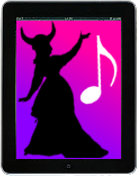Last Thursday I had the pleasure of meeting for coffee with Dan Molkentin, co-founder and co-artistic director of SingersBabel, the subscription-based website with lyric diction resources. He happened to be in town for the Music Library Association conference, so we took the opportunity to get together and talk shop. I knew at once that he was a kindred spirit when our conversation ranged from web technology stacks, media workflows, and website project management, to textual discrepancies in different composers’ setting of the same poems, Italianate vs. German Latin, and whether we should be rolling or vanishing our final R’s in German.
One piece of SingersBabel news that Dan shared was that they will be introducing Russian resources to the website in coming weeks. The resources will include multimedia guides for learning the basic sounds of the language, as well as guides for specific texts and repertoire. Speaking of repertoire, Dan tells me that the repertoire guides on the site will focus on choral works and oratorio, with a bit of art song to boot. (Although I REALLLLY hope – pretty please – that they’ll consider bringing some opera people on board to produce diction resources for the operatic repertoire and Italian. There’s an untapped market there, and even if they just did the arias from those ubiquitous Larsen anthologies, I bet they’d get business from a bunch of vocal performance majors and the like.)
We also talked about the recent SingersBabel website testing program, which I participated in. One thing that I discovered in the course of testing is that the website has many more resources than I thought; it’s just that they’re hard to find (and the SingersBabel team is working to rectify that). A sampling of notable resources:
- Audio comparison of vowel and consonant sounds in different languages (subscription required) – with special attention given to vowels that are transcribed with the same IPA symbol but have slightly different shadings in the various languages
- SingersBabel YouTube channel – song texts, IPA introduction, and more
- Dan’s YouTube channel – including his 35-minute Introduction to Lyric German Diction video
- And I really like this video on how to prepare a song text and really break down the text and diction components:
Dan shared some other online music resources with me as well. One of them, Peachnote, is something I’ve been meaning to check out for a while. From what I’ve gathered, Peachnote is a provider of a number of interesting music technologies, but one that particularly attracted Dan’s interest was Peachnote’s platform for collaborative online multimedia annotation of music scores. In plain English, that means that you can use Peachnote’s score viewer to annotate the score with your own text, audio, or video notes and also view annotations that others have added. Here’s a screen capture of Peachnote’s score viewer with annotations:
Peachnote also makes it possible to embed the score viewer in your own website, and in fact the viewer is already in use over at IMSLP with a number of scores. For example, you can go to the IMSLP page for Le nozze di Figaro, navigate to the full score for the overture, and click the “View” button:
The Peachnote viewer then displays the score, which someone has annotated with a YouTube video recording of a performance of the overture:
Dan also tipped me off to the Sparks and Wiry Cries blog and e-zine about art song. (I can’t believe I’ve never stumbled upon this.) From their masthead: “Our mission is to provide a virtual home for the art song community: performers, students, scholars and fans. We endeavor to provoke thoughtful discussion about the extraordinary art of song.” One of their contributors is Emily Ezust, creator and maintainer of The Lied, Art Song, and Choral Texts Archive, and they have a number of other notable contributors as well.
Lastly, Dan mentioned Medici TV, a French website which offers free live broadcasting of concerts, operas, and ballets along with video on demand from their catalog of concerts and classical music documentaries.
Thank you, Dan, for our engaging and enlightening conversation, and best of luck with the SingersBabel venture!
Related Posts:







